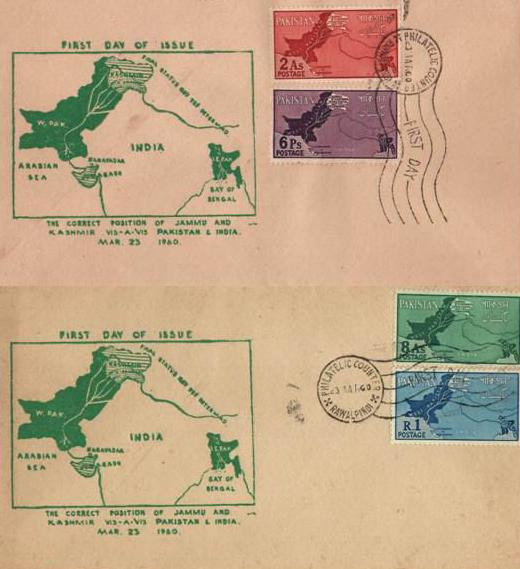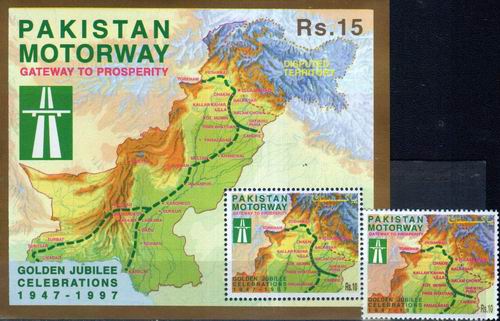“One cannot wage war under present conditions without the support of public opinion, which is tremendously molded by the press and other forms of propaganda.”
–Douglas MacArthur
In the last week of September this year, a furious India called off a meeting between External Affairs Minister Sushma Swaraj and her Pakistani counterpart Shah Mehmood Qureshi at the UN citing the release of postal stamps “glorifying” Hizbul Mujahideen Militant Burhan Wani who had been gunned down by the Indian Army in Kashmir.
Pakistan had released a Miniature Sheet of 20 stamps on July 8 this year to commemorate ‘Kashmir Martyr’s Day’.
A spokesperson of the MEA explained: “The latest brutal killings of our security personnel by Pakistan-based entities and the recent release of a series of 20 postage stamps by Pakistan glorifying a terrorist and terrorism confirm that Pakistan will not mend its ways.”
Terming the stamps as ‘Atrocities in Indian Occupied Kashmir’, the stamp set features stamps on human shields, victims of alleged chemical weapons, pellet guns, fake police encounters, braid chopping etc. The brochure issued with the stamp set gives a detailed commentary on these.
In her address at the United Nations, a combative Sushma Swaraj lambasted the duplicitous actions of Pakistan and thundered “The country prints postage stamps glorifying terrorists. If we do not act now, we will have to deal with conflagration later.”
This was a watershed moment in India’s Kashmir diplomacy as successive governments since independence, had turned a blind eye to Pakistan’s use of postage stamps as instruments of its brazen propaganda on Kashmir.
Propaganda has been the most effective tool for oppressive regimes to garner public support for their own ill deeds. Since 1947, Pakistan has perfected the art of fooling its people into believing what its all-powerful Army desires; a continued state of hostility, aggression vis-à-vis India and perpetual claim on the Indian State of Jammu & Kashmir.
Having suffered reverses in Operation Gulmarg in 1947 to capture Kashmir, Pakistan hit upon the idea of fooling its own people and the world community into believing that it had a legitimate claim over the erstwhile Princely State of Jammu & Kashmir. One clever tool in its bag of dirty tricks was Philately.
Stamps are perfect means of propaganda; cute little pictures often used to honour a nation’s heroes, momentous events, symbols and culture. Stuck on envelopes, they reach the far reaches of the country as well as across the world.
As early as 1954, Pakistan issued 2 stamps; the first of these of 9 pies denomination had a mountain peak in Gilgit with Pakistan’s flag.
The second stamp of 2 Annas denomination was on the Conquest of Mount K2; both areas were part of the erstwhile Princely State of Jammu & Kashmir and under illegal occupation by Pakistan.
In 1955, Pakistan went further and issued a set of 3 stamps, which depicted the map of what was at that time, West Pakistan. The stamps again conveniently showed the Pakistan Occupied Kashmir (PoK) as a permanent part of Pakistan.
Bolstered by the lack of challenge by the international community to its earlier blatant efforts, Pakistan released a set of 4 stamps in 1960. All these stamps depicted the area of Indian State of Jammu & Kashmir as ‘JAMMU & KASHMIR (FINAL STATUS NOT YET DETERMINED).
The First Day Covers of the set were even more inflammatory and stated ‘The correct position of Jammu & Kashmir vis-à-vis Pakistan & India March 23 1960’.
Clearly, by now Pakistan had changed its tactics and was laying claim to the entire state of Jammu & Kashmir. Pakistan was not making any headway in the battlefield or in international diplomacy, but it had already usurped entire Kashmir in stamps.
True to its position, in 1974 Pakistan issued another stamp of 20 paise denomination, titled ‘Shahrah-e Pakistan’.
The map showed PoK as part of Pakistan, while it depicted the Indian State as ‘Disputed territory’.
To maintain its illegal stand over Jammu & Kashmir and to fool its own people and the international community, Pakistan issued a set of 2 stamps in 1982 as part of its Independence Day celebrations.
The 85 paise stamp in this set had a map of Pakistan, which again depicted the Indian State of Jammu & Kashmir as ‘Disputed Territory’.
Evidently, Pakistan was working on a two-pronged strategy; that of legitimizing its own illegal occupation of part of J&K and also disputing the accession and merger of State of Jammu & Kashmir in the Indian Union. The lack of any appropriate response from India too helped its cause.
Postage stamps were an established tool of in its propaganda armamentarium by now. However, it was in 1985, that Pakistan’s philatelic brazenness reached its pinnacle. To commemorate the first ever SAARC meet in December in Bangladesh, Pakistan issued a set of 2 stamps, in which the 1 Rupee stamp depicted Jammu & Kashmir as a separate state from the Indian Union!
The Indian delegation was alerted to this incident and Prime Minister Rajiv Gandhi put his foot down and had a chat with the Pakistan PM Zia ul Haq, and demanded the stamps be withdrawn. Bowing to the pressure exerted by India, Pakistan had to withdraw the stamp set.
Unchastised by the previous experience, Pakistan issued yet another stamp and miniature sheet in 1997, which showed the map of Pakistan and depicted Jammu & Kashmir as ‘Disputed Territory’.
Pakistan, continuing its philatelic warfare issued a set of 3 stamps in 1999 to mark the silver jubilee of Allama Iqbal Open University, with the 5 Rupee stamp in the set showing PoK as part of its territory and the rest of Jammu & Kashmir as an independent country.
In 2004, Pakistan issued a stamp on the Silk Road, which showed Haramosh Peak in the Gilgit region. This was yet another attempt by Pakistan to give legitimacy to its illegal occupation of PoK.
In 2007 at the Economic Cooperation Organization (ECO) Summit, Pakistan issued a 10 Rupees stamp, which again showed PoK as part of its territory and the rest of Jammu & Kashmir as disputed territory.
In 2011, Pakistan issued a 10 Rupees stamp which showed the entire State of Jammu & Kashmir as an independent entity separate from India.
Working on the belief that If you repeat a lie often enough, it becomes the truth, Pakistan hoped that the International Community will start looking upon Kashmir as a flashpoint between 2 nuclear nations fighting over a ‘disputed territory’.
Pakistan has also used stamps as propaganda for other issues as well. After its resounding defeat at the hands of the Indian Armed Forces in the 1971 war, over 90,000 Pakistan Army soldiers had tamely surrendered to the Indian Army. These Prisoners of War were dealt with in a just and humane manner by the Indian Army and imprisoned in camps across India. However, this didn’t stop Pakistan from issuing a stamp of the denomination of 1.25 Rupees in 1973, with ’90,000 Prisoners of War in India, Challenge to World Conscience’written over it.
Even the First Day Cover issued on 18th April 1973 mentioned ’90,000 Pakistani Prisoners of War Languishing in Indian Camps for over 15 months’.
This is hilarious and ironical as generations of Pakistani kids have been taught that the Instrument of Surrender was mistakenly signed by General Niaz.
After lying and deceiving the entire world that its regular army soldiers were not a part of the Kargil intrusion in India in 1999, in a tacit admission of the fact that its troops were indeed part of the Kargil misadventure, Pakistan quietly issued a set of 3 stamps in 2013, which honoured 3 of its Northern Light Infantry Soldiers with Pakistan’s highest gallantry award ; Nishan-e-Haider as well as with Hilal – I- Kashmir.
This exposed how Pakistan routinely lies and tries to deceive the international community about its military aggression.
Unable to defeat India militarily in the 4 wars fought between the two countries, Pakistan has chosen a low cost agenda to bolster its proxy war against India; that of using philately.
In the last 3 decades, India has been the victim of cross border terrorism inflicted on it by terrorists, trained and supported by Pakistan. Mumbai serial blasts, train bombings, the attack on the Parliament, 26/11 attacks; the list is endless. Thousands of innocent Indians have lost their lives in these Pakistan sponsored attacks. Yet till date, India has failed to use philately as a mean and a tool to educate and sensitize the global community to the dastardly acts of Pakistan.
In a first, in 2015 India issued a set of 3 stamps titled ‘Valour & Sacrifice – 1965 War’, to commemorate 50 years of the 1965 war.
However, India must do a great deal more.
India has not issued map stamps since 1957.It has also failed to issue any stamps for its military victories of 1948, 1965, 1971 or even the 1999 Kargil war. Not only have this, the military campaigns for liberation of Goa, Operation Meghdoot, Operation Cactus etc, have all gone largely uncelebrated.
This asymmetry needs rectification at the earliest.
India has unparalleled philatelic firepower, and yet till date it has failed to land any counter-punches in response to the Pakistani propaganda. With 155,015 post offices, India Post has the most widely distributed postal network in the world. India Post also has over 68 philately bureaus and 1111 philatelic counters, including all head post offices. Indian stamps are also amongst the most sought-after collector items across the globe.
India can use these strengths to counter Pakistan propaganda effectively and also sensitize the international community to the terrorist activities that Pakistan routinely indulges in India. A campaign of special releases of stamps with such themes can be printed in bulk and supplied across various bureaus globally.
India also has enormous reach and access across the globe. The fast-growing GDP and the large middle class offers large opportunities to various countries to invest in India. India should leverage these strengths to strip Pakistan of its façade on Kashmir & also expose it as the global epicentre of terrorism.
Philately, in tandem with its diplomatic prowess, and growing international economic power and soft clout, can take the wind out of Pakistan’s sails. All it requires is a little willpower and concerted effort by the government and other stakeholders. We cannot afford to ignore our philatelic muscle.





















